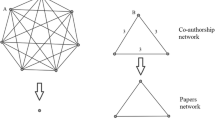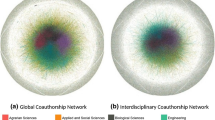Abstract
Over the past decade there have been many investigations aimed at defining the role of scientists and research groups in their coauthorship networks. Starting from the assumptions of network analysis, in this work we propose an analytical definition of a collaboration potential between authors of scientific papers based on both coauthorships and content sharing. The collaboration potential can also be considered a useful tool to investigate the relationships between a single scientist and research groups, thus allowing for the identification of characteristic “types” of scientists (integrated, independent, etc.). We computed the collaboration potential for a set of authors belonging to research groups of an institute specialized in the field of Medical Genetics. The methods presented in the paper are rather general as they can be applied to compute a collaboration potential for a network of cooperating actors in every situation in which one can qualify the content of some activities and which of them are in common among the actors of the network.





Similar content being viewed by others
Notes
Please refer to http://www.operapadrepio.it/m.jpg.
References
Barabási, A.-L. (2002). Linked-the new science of networks. Cambridge, MA: Perseus Press.
Barabási, A.-L., & Albert, R. (1999). Emergence of scaling in random networks. Science, 286, 509–512.
Bassecoulard, E., & Zitt, M. (1999). Indicators in a research institute: A multi-level classification of scientific journals. Scientometrics, 44(3), 323–345.
Beaver, D. D. (2001). Reflections on scientific collaboration (and its study): Past, present and future. Scientometrics, 52, 365–377.
Berners-Lee, T., & Hendler, J. (2001). Publishing on the semantic web. Nature, 410, 1023–1024.
Bollen, J., Van de Sompel, H., Hagberg, A., & Chute, R. (2009). A principal component analysis of 39 scientific impact measures. PLoS One, 6(4):1–11.
Bollen, J., Van de Sompel, H., Smith, J. A., & Ruce, L. (2005). Toward alternative metrics of journal impact: A comparison of download and citation data. Information Processing & Management, 41(6), 1419–1440.
Borgatti, S. P. (2006). Identifying sets of key players in a network. Computational, Mathematical and Organizational Theory, 12(1), 21–34.
Börner, K. B., DallAsta, L., Ke, W., & Vespignani, A. (2005). Studying the emerging global brain: Analyzing and visualizing the impact of co-authorship teams. Complexity, 10(4), 57–67.
Boyack, K. W. (2009) Using detailed maps of science to identify potential collaborations. Scientometrics, 79(1), 27–44.
Burger, M., & Bujdosó, E. (1984). Oscillating chemical reactions as an example of the development of a subfield of science. In J. R. Field & M. Burger (Eds.), Oscillating and traveling waves in chemical systems (pp. 565–604). New York: Wiley.
Carvalho, R., & Batty, M. (2006). The geography of scientific productivity: scaling in the U.S. computer science. Journal of Statistical Mechanics, 10, P10012–P10017.
Chen, H., Ding, L., Wu, Z., Yu, T., Dhanapalan, L., & Chen, J. Y. (2009). Semantic web for integrated network analysis in biomedicine. Briefings in Bioinformatics, 10(2), 177–192.
De Nooy, W., Mrvar, A., & Botagelj, V. (2005). Exploratory social network analysis with Pajek. New York: Cambridge University Press.
de Solla Price, D. J. (1965). Networks of scientific papers. Science, 149(3683), 510–515.
Frenken, K., Hardemann, S., & Hoekman, J. (2009). Spatial scientometrics: Towards a cumulative research program. Journal of Informetrics, 3, 222–232.
Garfield, E. (1972). Citation analysis as a tool in journal evaluation. Science, 178, 47–79.
Garfield, E., Pudovkin, A. I., & Istomin, V. S. (2002). Algorithmic citation-linked historiography mapping the literature of science. In ASIS&T 2002: Information, connections and community. 65th Annual meeting of ASIST in Philadelphia, PA, November 18–21, 2002.
Girvan, M., & Newman, M. E. (2002). Community structure in social and biological networks. Proceedings of the National Academy of Sciences of the United States of America, 99(12), 7821–7826.
Glänzel, W. (2003). Bibliometrics as a research field. A course on the theory an application of bilbiometric indicators. http://www.citeseerx.ist.psu.edu/viewdoc/download?doi=10.1.1.97.5311&rep=rep1&type=pdf.
Hendler, J. (2003). Science and the semantic web. Science, 299, 520–521.
Hirsch, J. E. (2005). An index to quantify an individual’s scientific research output. Proceedings of the National Academy of Sciences of the United States of America, 102, 16569–16572.
Hoekman, J., Frenken, K., & van Oort, F. (2009). The geography of collaborative knowledge production in Europe. Annals of Regional Science, 43, 721–738.
Katz, J. S., & Martin, B. R. (1997). What is research collaboration? Research Policy, 26, 1–18.
King, D. A. (2004). The scientific impact of nations. Nature, 430, 311–316.
Kretschmer, H. (1985). Cooperation structure, group size and productivity in research groups. Scientometrics, 1–2, 39–53.
Kretschmer, H. (1990). Social stratification of authors revealed from the coauthorship network. In L. Egghe & R. Rousseau (Eds.), Informetrics 89/90, Proceedings of the 2nd international conference on bibliometrics, informetrics and scientometrics (pp. 193–209) held in London (Canada), 5–7 July, 1989. Amsterdam: Elsevier Science Publishers.
Kretschmer, H. (1994). Coauthorship networks of invisible colleges and institutionalized communities. Scientometrics, 1, 363–369.
Kretschmer, H. (2002). Similarities and dissimilarities in coauthorship networks: Gestalt theory as explanation for well-ordered collaboration structures and production of scientific literature. Library Trends, 50(3), 474–497.
Lambiotte, R., & Panzarasa, P. (2009). Communities, knowledge creation and information diffusion. Journal of Informetrics, 3, 180–190.
Laudel, G. (2002). What do we measure by co-authorship? Research Evaluation, 11(1), 3–15.
Newman, M. E. J. (2004). Coauthorship networks and patterns of scientific collaboration. Proceedings of the National Academy of Sciences of the United States of America, 101(1), 5200–5205.
Newman, M., Barabási, A., & Watts D. J. (Eds). (2006). The structure and dynamics of networks. Princeton, NJ: Princeton University Press.
Panzarasa, P., Opsahl, T., & Carley, K. M. (2009). Patterns and dynamics of users’ behavior and interaction Network analysis of an online community. Journal of the American Society for Information Science and Technology, 60(5), 911–932.
R Development Core Team. (2008). R: A language and environment for statistical computing. R Foundation for Statistical Computing, Vienna. ISBN 3-900051-07-0, http://www.R-project.or.
Shiffrin, R. M., & Börner, K. (2004). Mapping knowledge domains. Proceedings of the National Academy of Sciences of the United States of America, 101, 5183–5185.
Shinn, T. (2006). New sources of radical innovation: Research technologies, transversality, and distributed learning in a post-industrial order. In J. Hage & M. T. H. Meeus (Eds.), Innovation, science and institutional change. Oxford: Oxford University Press.
Sonnenwald, D. H. (2007). Scientific collaboration. Annual Review of Information Science and Technology, 41, 643–681.
Szklo, M. (2008). Impact factor: Good reasons for concern. Epidemiology, 19, 369.
Trieschnigg, D., Pezik, P., Lee, V., de Jong, F., Kraaij, W., & Rebholz-Schuhmann, D. (2009). MeSH Up: Effective MeSH text classification for improved document retrieval. Bioinformatics, 25(11), 1412–1418.
Westney, L. C. H. (1998). Historical rankings of science and technology: A citationist perspective. Journal of the Association for History and Computing, 1(1).
Whitley, R. (2000). The intellectual and social organization of the sciences (2nd ed.). Oxford: Clarendon Press.
Zweigenbaum, P., Demner-Fushman, D., Yu, H., & Cohen, K. B. (2007). Frontiers of biomedical text mining: Current progress. Briefings in Bioinformatics, 8(5), 358–375.
Acknowledgements
We wish to thank Filippo Radicchi (Complex Networks Lagrange Laboratory, Turin) and Pietro Leo (IBM Research, Bari) for their precious insights and suggestions. We wish also to thank Nicole Shirilla (University of Pittsburgh) for a revision of the language. This work was partly supported by the Italian Ministry of Health grant RC0904IC63.
Author information
Authors and Affiliations
Corresponding author
Appendix
Appendix
Questionnaire in English
-
1.
Suppose to divide into two sections the work you do in collaboration with other researchers: assign the first one to work done with colleagues of your research group, and the second one to work done with colleagues outside your research group. Express in percentual the size of each section (sum must be 100).
-
2.
Consider your publications in the last six years. Choose, among the groups listed in the table below, the one that could have been more involved in your work.
Original questionnaire in Italian
-
1.
Supponi di assegnare un punteggio pari al 100% al lavoro che svolgi in collaborazione con altri ricercatori (del tuo o di altri gruppi di ricerca). Dividi questo punteggio in una parte legata al lavoro in collaborazione con i colleghi del tuo gruppo di ricerca e una parte legata al lavoro in collaborazione con colleghi esterni al tuo gruppo.
-
2.
Considerando le tue pubblicazioni scientifiche degli ultimi sei anni indica il gruppo di ricercatori che avresti potuto coinvolgere più di quanto non sia già avvenuto.
Rights and permissions
About this article
Cite this article
Giuliani, F., De Petris, M.P. & Nico, G. Assessing scientific collaboration through coauthorship and content sharing. Scientometrics 85, 13–28 (2010). https://doi.org/10.1007/s11192-010-0264-y
Received:
Published:
Issue Date:
DOI: https://doi.org/10.1007/s11192-010-0264-y




